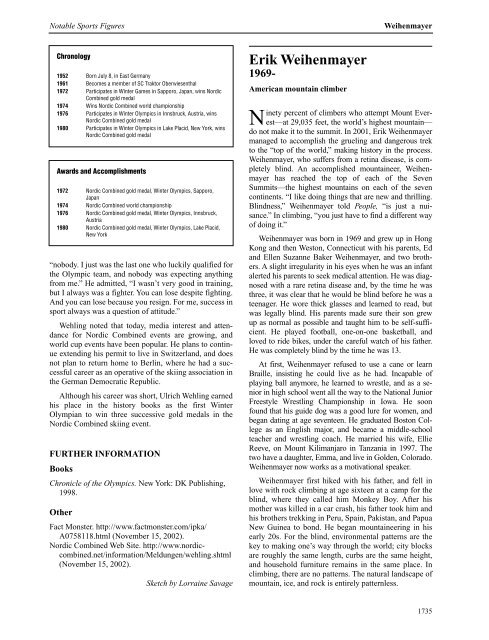Frank Thomas
Frank Thomas
Frank Thomas
Create successful ePaper yourself
Turn your PDF publications into a flip-book with our unique Google optimized e-Paper software.
Notable Sports Figures<br />
Chronology<br />
1952 Born July 8, in East Germany<br />
1961 Becomes a member of SC Traktor Oberwiesenthal<br />
1972 Participates in Winter Games in Sapporo, Japan, wins Nordic<br />
Combined gold medal<br />
1974 Wins Nordic Combined world championship<br />
1976 Participates in Winter Olympics in Innsbruck, Austria, wins<br />
Nordic Combined gold medal<br />
1980 Participates in Winter Olympics in Lake Placid, New York, wins<br />
Nordic Combined gold medal<br />
Awards and Accomplishments<br />
1972 Nordic Combined gold medal, Winter Olympics, Sapporo,<br />
Japan<br />
1974 Nordic Combined world championship<br />
1976 Nordic Combined gold medal, Winter Olympics, Innsbruck,<br />
Austria<br />
1980 Nordic Combined gold medal, Winter Olympics, Lake Placid,<br />
New York<br />
“nobody. I just was the last one who luckily qualified for<br />
the Olympic team, and nobody was expecting anything<br />
from me.” He admitted, “I wasn’t very good in training,<br />
but I always was a fighter. You can lose despite fighting.<br />
And you can lose because you resign. For me, success in<br />
sport always was a question of attitude.”<br />
Wehling noted that today, media interest and attendance<br />
for Nordic Combined events are growing, and<br />
world cup events have been popular. He plans to continue<br />
extending his permit to live in Switzerland, and does<br />
not plan to return home to Berlin, where he had a successful<br />
career as an operative of the skiing association in<br />
the German Democratic Republic.<br />
Although his career was short, Ulrich Wehling earned<br />
his place in the history books as the first Winter<br />
Olympian to win three successive gold medals in the<br />
Nordic Combined skiing event.<br />
FURTHER INFORMATION<br />
Books<br />
Chronicle of the Olympics. New York: DK Publishing,<br />
1998.<br />
Other<br />
Fact Monster. http://www.factmonster.com/ipka/<br />
A0758118.html (November 15, 2002).<br />
Nordic Combined Web Site. http://www.nordiccombined.net/information/Meldungen/wehling.shtml<br />
(November 15, 2002).<br />
Sketch by Lorraine Savage<br />
Erik Weihenmayer<br />
1969-<br />
American mountain climber<br />
Weihenmayer<br />
Ninety percent of climbers who attempt Mount Everest—at<br />
29,035 feet, the world’s highest mountain—<br />
do not make it to the summit. In 2001, Erik Weihenmayer<br />
managed to accomplish the grueling and dangerous trek<br />
to the “top of the world,” making history in the process.<br />
Weihenmayer, who suffers from a retina disease, is completely<br />
blind. An accomplished mountaineer, Weihenmayer<br />
has reached the top of each of the Seven<br />
Summits—the highest mountains on each of the seven<br />
continents. “I like doing things that are new and thrilling.<br />
Blindness,” Weihenmayer told People, “is just a nuisance.”<br />
In climbing, “you just have to find a different way<br />
of doing it.”<br />
Weihenmayer was born in 1969 and grew up in Hong<br />
Kong and then Weston, Connecticut with his parents, Ed<br />
and Ellen Suzanne Baker Weihenmayer, and two brothers.<br />
A slight irregularity in his eyes when he was an infant<br />
alerted his parents to seek medical attention. He was diagnosed<br />
with a rare retina disease and, by the time he was<br />
three, it was clear that he would be blind before he was a<br />
teenager. He wore thick glasses and learned to read, but<br />
was legally blind. His parents made sure their son grew<br />
up as normal as possible and taught him to be self-sufficient.<br />
He played football, one-on-one basketball, and<br />
loved to ride bikes, under the careful watch of his father.<br />
He was completely blind by the time he was 13.<br />
At first, Weihenmayer refused to use a cane or learn<br />
Braille, insisting he could live as he had. Incapable of<br />
playing ball anymore, he learned to wrestle, and as a senior<br />
in high school went all the way to the National Junior<br />
Freestyle Wrestling Championship in Iowa. He soon<br />
found that his guide dog was a good lure for women, and<br />
began dating at age seventeen. He graduated Boston College<br />
as an English major, and became a middle-school<br />
teacher and wrestling coach. He married his wife, Ellie<br />
Reeve, on Mount Kilimanjaro in Tanzania in 1997. The<br />
two have a daughter, Emma, and live in Golden, Colorado.<br />
Weihenmayer now works as a motivational speaker.<br />
Weihenmayer first hiked with his father, and fell in<br />
love with rock climbing at age sixteen at a camp for the<br />
blind, where they called him Monkey Boy. After his<br />
mother was killed in a car crash, his father took him and<br />
his brothers trekking in Peru, Spain, Pakistan, and Papua<br />
New Guinea to bond. He began mountaineering in his<br />
early 20s. For the blind, environmental patterns are the<br />
key to making one’s way through the world; city blocks<br />
are roughly the same length, curbs are the same height,<br />
and household furniture remains in the same place. In<br />
climbing, there are no patterns. The natural landscape of<br />
mountain, ice, and rock is entirely patternless.<br />
1735

















